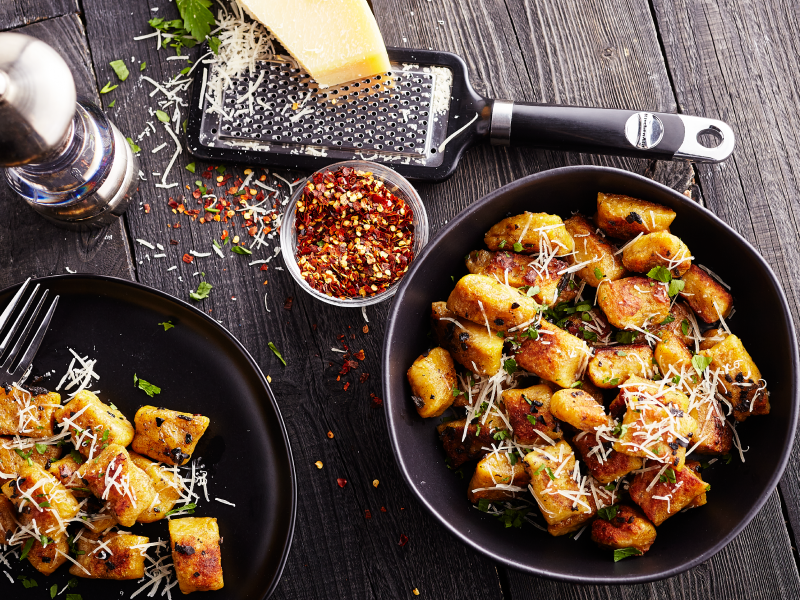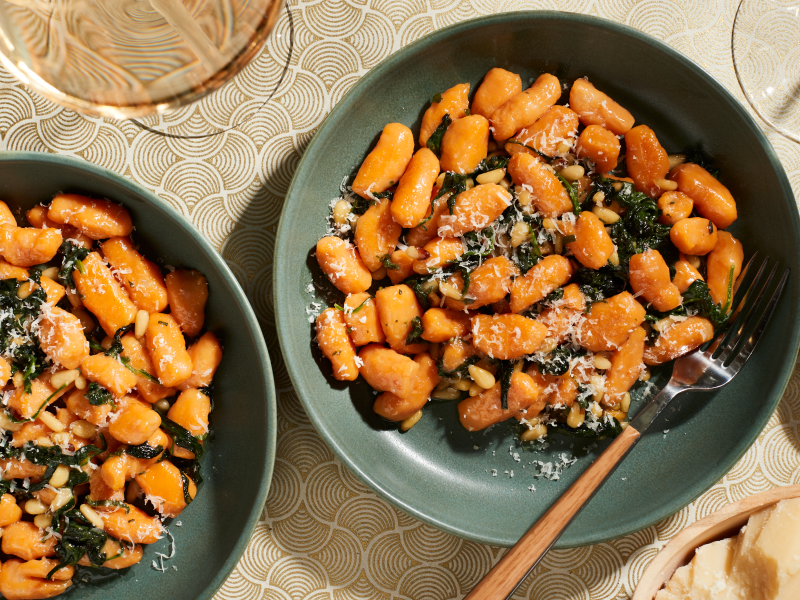
How To Make Gnocchi With a Stand Mixer
Gnocchi is a type of Italian pasta most commonly made of potato, flour and eggs. They are small, pillowy pieces that resemble dumplings. With a light and airy texture, gnocchi are versatile as they can be used in a variety of recipes from a simple olive oil and herb combination to complex pasta sauces.
Follow this guide for steps on how to make homemade gnocchi using a stand mixer, along with attachments and accessories. Learn the secrets to making and cooking delicious, fresh gnocchi.


Homemade gnocchi recipe
Making fresh gnocchi only requires four main ingredients. Although there are many ways you can customize your own signature recipe, it’s the process that you’ll want to follow closely in order to achieve a fluffy, pillowy texture. Using a KitchenAid® stand mixer and attachments1 to prepare the dough can streamline your making and offer precision for consistently delicious results.
1. Sold separately.
YIELDS
4 servings
INGREDIENTS
Potatoes
All-purpose flour
Egg
Salt
Gnocchi sauce
TOOLS
KitchenAid® stand mixer with pastry beater accessory1
KitchenAid® food grinder attachment (optional)
Baking sheet pan
Large cooking pot or pasta pot with strainer
Fork or gnocchi board
Sharp knife
Slotted spoon
Large saucepan
1. Sold separately.
PREP TIME
80 minutes
COOK TIME
5 minutes
TOTAL TIME
85 minutes

Step 1. Bake the potatoes
Heat your oven to 425°F/218°C. Slice the potatoes in half and place them flesh side down on a baking sheet. Put the baking sheet in a preheated oven and bake until fork tender, about 40 minutes.

Step 2. Cool and peel potatoes
Allow the potatoes to cool to room temperature. Once the potatoes are baked and easily handled, peel the skins off and discard.

Step 3. Mash the potatoes
For the best results, process the potatoes using a KitchenAid® stand mixer food grinder attachment1 with a fine grinding plate. This technique can produce light, fluffy gnocchi dough. Position mixer bowl under the attachment. Turn the mixer to speed 4 and grind the potatoes.
If you don’t yet have the food grinder attachment, you can also use a pastry beater accessory or your included flat beater for this step. Simply scoop the potato flesh into your stand mixer bowl. Start on speed 2, then increase speed to 6 and mash the potatoes for 30 seconds. Turn off your stand mixer.
1. Sold separately.

Step 4. Knead the dough
Remove the food grinder or beater and attach your dough hook.
Add the salt and egg, then turn the stand mixer to speed 2. With the mixer turning, add the flour, about 1/2 cup at a time. As soon as each flour addition is combined, immediately add the next portion. Turn off the mixer once the last addition is incorporated to avoid over processing the dough.
The dough will be loose. If it is too sticky to handle, add another 1/4 cup of flour before removing it from the bowl.

Step 5. Roll and shape the dough
Lightly flour your hands and remove the dough from the mixer. (It will be sticky as you start to knead it.) With a gentle touch, knead the dough lightly on a floured surface, dusting the counter with flour as you work, just until dough is workable.
Divide the dough into equal pieces. Working one piece at a time, roll dough into a thin cylinder about 1/2” in diameter. Cut the cylinder into 1/2” inch pieces, then roll each piece over tines of fork (or gnocchi board) to indent. Transfer to a baking sheet pan and allow them to rest for about 20 minutes. You’ll want them to air dry so they hold their shape while cooking.

Step 6. Blanch gnocchi
To cook the gnocchi, bring a large pot of salted water to a boil. Add half of the gnocchi to the boiling water and stir. Let the gnocchi cook until they float back up to the top, then cook about 1 minute more.
Remove the gnocchi with a slotted spoon to a baking sheet pan and allow to dry for a few minutes before adding to your sauce. Repeat the cooking process with the remaining gnocchi.

Step 7. Heat the sauce and add gnocchi
Add the gnocchi to your favorite sauce that’s simmering in a large saucepan to incorporate the flavors. Garnish with flavorful delights such as olive oil, herbs and Parmesan cheese, serve and enjoy!
Shop KitchenAid® Stand Mixer Attachments and Accessories


What is the best flour for gnocchi?
For authentic gnocchi, the best flour to use is Italian Tipo 00 Flour. It’s a finely ground, soft flour from Italy that lends to light and silky gnocchi. While this may be the ideal flour, the more common all-purpose flour can also be used in creating the soft, melt-in-your-mouth texture of gnocchi.
For more tips on flour types, preparing, cooking and storing homemade pasta, check out how to make pasta with a KitchenAid® stand mixer.


What is the best type of potato for gnocchi?
The best types of potatoes to use when making gnocchi are Russet or Idaho potatoes because of their drier texture. They are higher in starch and tend to hold less moisture. A dry potato consistency may require less flour which can create a lighter, creamier gnocchi.
Instead of Russet or Idaho potatoes, you can also try sweet potatoes for your homemade gnocchi recipe. With a similar consistency, they also have a lower moisture content which can set you up with a fluffier, mouthwatering gnocchi.
Do I need to add an egg to gnocchi?
Some gnocchi recipes skip the egg when baking instead of boiling it, making the recipe adaptable for those following a vegan or plant-based diet. The egg acts like a binder to hold the dough together. That’s why it’s important when it comes to boiling gnocchi, but not necessarily when baking it.
Can I overwork gnocchi dough?
Yes, gnocchi dough can be overworked by too much handling. Over-kneading the dough may result in creating too much gluten. This can lead to gnocchi that has a more chewy, rubbery texture. The key is to use as little flour as possible to create a light, airy texture.


Can I bake gnocchi instead of boiling it?
Yes, you can bake gnocchi instead of boiling it. Simply prepare the sauce as desired, then combine the ingredients with the gnocchi and bake in the oven. You can also pan fry your gnocchi, although it may take longer to cook if you don’t boil it first.
Can gnocchi be frozen?
While eating gnocchi after it’s freshly made is preferred and can taste better to discerning palates, you can also freeze it. Make sure to freeze it after it’s freshly made and before you boil it. Spread the individual pieces out on a baking sheet, spacing them apart and put them in the freezer.
Once the gnocchi is frozen, you can store it in a plastic bag or airtight container. To discover more about storing pasta, you may want to check out how to store fresh, homemade pasta.


How do I serve gnocchi?
You can make a variety of dishes with fresh gnocchi. Create a light and refreshing dish by simply sautéing it with butter or olive oil and fresh herbs. Add in vegetables, herbs and spices, and mix with this kale pesto recipe. You can even bake gnocchi with your favorite hearty meat sauce or add it to soups.
Enjoy experimenting with the base ingredients for the gnocchi itself. Try butternut squash, sweet potatoes with brown butter honey sauce, or spinach gnocchi with garlic basil oil. There are also gluten-free options such as this ricotta gnocchi.
Shop for KitchenAid® Stand Mixers
Whether you’re making fresh dumplings such as homemade gnocchi or exploring your latest baking passions, a KitchenAid® stand mixer can help you unlock new techniques and streamline your making. With so many stand mixers to choose from, the possibilities are endless.